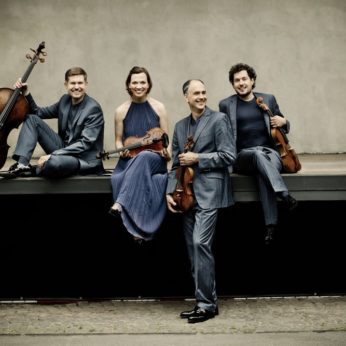Composer: Joseph Haydn (b. 1732 - d. 1809)
Performance date: 25/06/2022
Venue: St. Brendan’s Church
Composition Year: 1772
Duration: 00:23:16
Recording Engineer: Jason Fallon, Ergodos
Instrumentation: 2vn, va, vc
Instrumentation Category:String Quartet
Artists:
Signum Quartet (Florian Donderer, Annette Walther [violins], Xandi van Dijk [viola], Thomas Schmitz [cello]) -
[String Quartet]

Joseph Haydn [1732-1809]
Quartet in E flat Op.20/1 [1772]
1. Allegro Moderato
2. Minuet un poco allegretto
3. Affettuoso e sostenuto
4. Presto
In 1766 Gregor Werner the elderly Kapellmeister at the court of the Esterhazy family died. His place was taken by his assistant Joseph Haydn who immediately threw himself into the arduous tasks of not only composing music (symphonies, operas, masses, trios, sonatas etc.) but also conducting orchestral performances, appointing musicians and maintaining their instruments. One thing he was not required to do was compose string quartets. Nevertheless, within two years, he had completed a set of six quartets (opus 9). These quartets would have been performed in private probably by members of the Esterhazy orchestra including, of course, Haydn himself.
Another set of six followed in 1770 and then in 1772, Haydn completed the opus 20 quartets. A breakthrough had occurred. Not only were these overall significantly longer than before, they also gave much larger parts to the second violin, viola and particularly the cello. They were now active participants in the work as a whole. In addition, the opus 20 quartets have a number of features which set them apart from the rest of Haydn’s quartets. As one critic wrote in 1790; in opus 20, Haydn emerges in his full greatness as a quartet composer.
.
This E flat quartet was not Haydn’s choice as the first of the set. Publishers, and there were a number of them, usually put this quartet first as it provided an attractive and relatively easy beginning. Even so, in the opening bars of the first movement Haydn provides some harmonic surprises. In typical sonata form, the first set of themes are supposed to be in the tonic (or home key) in this case E flat. A modulation to the dominant key (in this case B flat) is only supposed to happen when the second group of themes is introduced usually many bars later. Haydn begins this modulation in bar 7 (the first violin introduces it with a couple of trills) and then switches between the two keys before the B flat is firmly established in bar 21 (after a brief first violin solo)
These harmonic changes, typical of Haydn, give the affable opening theme a more stimulating even subversive flavour. The movement proceeds in a wonderfully intricate way. Haydn rewrites his themes for the recapitulation without any of the earlier key modulations. This provides a very satisfying resolution to the movement. No wonder Beethoven chose to copy out this quartet as he worked on his first set of six string quartets (opus 18).
After the complexities of the first movement, the minuet is straightforward. The wonderful slow movement has a dream like serenity with apparently hardly any rhythmic or even melodic structure. This so impressed Mozart that he used it as a model for the slow movement of the E flat quartet which he dedicated to Haydn. The finale makes no attempt to resist the comic. The viola and cello wittily respond to the two violins in the first subject and exuberant passages of syncopation follow; In the rumbustious development, Haydn uses a serious device to achieve a comic effects. To quote one more critic, in this work “the string quartet was born”
David Winter
Copyright © 2025 West Cork Music. All rights reserved.
Designed and developed by Matrix Internet